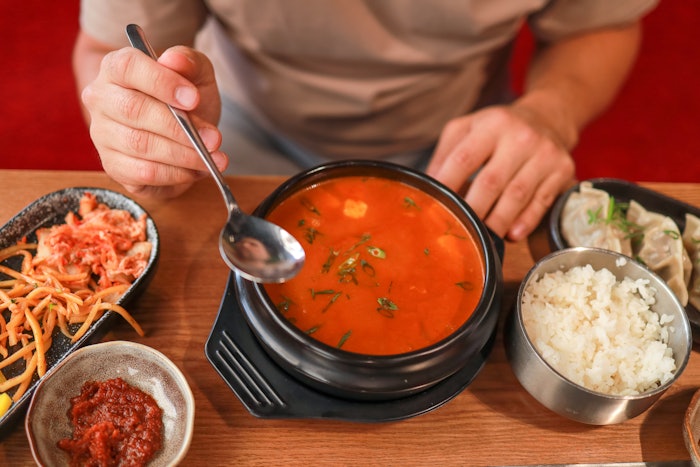
The savory foods industry is evolving fast, driven by changing lifestyles, shifting Darrel Fletcher, vice president, global culinary, Taste IFF Courtesy of IFF
Darrel Fletcher, vice president, global culinary, Taste IFF Courtesy of IFF
This article is only available to registered users.
Log In to View the Full Article
The savory foods industry is evolving fast, driven by changing lifestyles, shifting Darrel Fletcher, vice president, global culinary, Taste IFF Courtesy of IFF
Darrel Fletcher, vice president, global culinary, Taste IFF Courtesy of IFF
We believe that great products should “taste like joy,” rooted in local culture, yet inspired by global trends. Here are ten key movements shaping the future of savory foods, and how they can be tailored to deliver delight in every region.
1. Fusion Cuisine: Blurring Borders, Building Flavor Bridges
Fusion is no longer niche; it’s a strategic playground for innovation, with 47% of food industry professionals selecting global fusion flavors as the top flavor direction for 2025. Consumers, especially younger generations, are eager to explore new flavors and adventurous taste experiences.
Fusion cuisine offers a sense of adventure and novelty, allowing people to experiment with creative pairings. Travel, social media, and migration have broadened palates and made consumers open to non-authentic “cuisine clashes”.
From high-end restaurants to street food cantinas and social media, we observe a Christina Papadam, senior manager, innovation marketing, Culinary, Taste IFFCourtesy of IFF
Christina Papadam, senior manager, innovation marketing, Culinary, Taste IFFCourtesy of IFF
Moving forward, the challenge to develop successful new products and menus inspired by fusion cuisine is how to spark curiosity while keeping a broad appeal. Flavor storytelling becomes key to building emotional connections with adventurous consumers.
2. Bold & Spicy: Turning Up the Heat Globally
According to Mintel, 55% of Gen Z consumers in the US are interested in spicy dips, sauces and dressings, while an equal percentage of Indian consumers prefer extra-spicy flavors in traditional snacks. The appetite for hot and spicy flavors is clearly on the rise, with consumers around the world seeking bolder, more adventurous taste experiences.
Younger consumers may be leading the charge, but all age groups are engaged. Spicy foods are seen as both exciting and comforting, offering a physical kick and an emotional lift, while elevating the overall flavor of the dish.
Consumers enjoy experimenting with spice levels, with restaurants and brands offering customizable heat (e.g., spice scales, “hot challenges”). Regional cuisines known for their heat (Sichuan peppers, Korean gochujang, Mexican chipotle and more) are inspiring new product launches globally. Brands highlight specific chili types to communicate intensity and authenticity. Reflecting this growing demand, the global hot sauce market is projected to grow at a CAGR of 10% over the next decade.
Swicy (fusion of sweet and spicy) seen in products like hot honey, mango habanero and sweet chili sauces have moved from niche to mainstream. This “swicy” trend helps temper heat for wider appeal and enables innovation in snacks, condiments, and mini meals.
Localization matters: successful products balance fire with flavor, create scalable heat levels and adapt spice levels and formats to regional preferences.
3. Smoked & Grilled Flavors: Fire-Crafted Authenticity
Smoky, roasted and flame-grilled flavors are no longer confined to street corners or back yards, they’re blazing in supermarket aisles through snacks, sauces, meats and ready meals. According to Mintel, smoke, roasted and grilled flavor profiles are among top 10 flavor descriptors in new launches. In fact, 46% of consumers in the US alone are interested in smoky flavors (e.g., hickory, Applewood) for bacon, hot dog, and sausage product innovations, making it the most popular flavor innovation in this segment. Inspired by global street food rituals from around the world (think yakitori stalls in Tokyo or South American asado pits), these fire-crafted notes deliver layered depth and primal satisfaction.
Consumers crave the emotional warmth of open-fire cooking: it’s nostalgic, social and deliciously familiar. Innovation continues through signature smoky characters (chicory, applewood), multi-layered taste of smoky, sweet and salty notes, unexpected combinations (roasted pineapple chili) and global barbecue inspirations, However, regulatory shifts in Europe may drive further evolution in how these flavors are delivered.
4. Multisensorial Exploration: Eating with All Senses
Texture, aroma, and visual drama are becoming central to product design. Multisensorial exploration is thriving thanks to social media, which amplifies visually and experientially engaging foods, with 40% of consumers in Thailand agreeing that multisensory food and drink can boost their mood (Mintel). This trend is driving innovation, emotional connection, and inclusivity in food, as brands and consumers alike seek out and share memorable, multi-sensory eating experiences online.
Think crunchy toppings on creamy soups or pot noodles, sizzling sauces, foam, and colour changing cooking aids. Developers are innovating with layered textures, interactive packaging, and aroma enhancing formats to elevate everyday meals and thrive in social media.
 There is a growing demand among consumers for familiar childhood flavors, such as mac and cheese, with an elevated twist.utaem2022 at Adobe Stock
There is a growing demand among consumers for familiar childhood flavors, such as mac and cheese, with an elevated twist.utaem2022 at Adobe Stock
5. Comfort Food Reinvented: Nostalgia with a Twist
Comfort food remains a powerful and enduring trend globally, especially in times of uncertainty and crisis. Consumers increasingly look to food and drink for emotional reassurance, nostalgia, and moments of joy.
Despite the rise of global influences and new culinary experiences, consumers consistently gravitate toward familiar flavors that remind them of their childhood or cultural heritage. Globally, there's a revival of childhood favorites (mac & cheese, meatballs, noodle soups) reimagined with premium ingredients, ethnic spices or plant-based swaps.
For instance, 65% of UK consumers enjoy products that remind them of their past, 51% of Brazilians favor childhood flavors and 70% of Spanish consumers prefer eating the same chocolate products they enjoyed as children. This trend offers emotional resonance while allowing for innovation in format and flavor. For example: how would you reinvent the classic chicken soup?
6. Convenience & Versatility: Smart Solutions for Busy Lives
Modern consumers are juggling work, family and social commitments, leaving less time for meal preparation. As a result, they seek products that save time and effort, such as ready meals, cooking aids and foods compatible with kitchen appliances like microwaves and air fryers.
Consumers want to maintain the quality of home-cooked meals while reducing the time spent in the kitchen. This drives the opportunity for premiumization, as consumers are willing to pay for products that offer elevated convenience without sacrificing taste or nutrition.
Consumers value products that are adaptable and versatile, able to serve multiple meal occasions, dietary needs or cooking methods. Versatile sauces that can also act as cooking aids allow for creativity and customization, helping home-cooks master their kitchen routines.
7. Mindful Eating: New Health & Wellbeing
With the rise of GLP-1 medications, brands are adapting to evolving consumer needs — embracing smaller portions, higher protein content and shifting taste preferences, including reduced tolerance for fatty or spicy notes.
IFF continues to conduct culinary research across North America to better understand how GLP-1 usage is influencing flavor perception and dietary behavior.
- Added: Fortified with extra nutrients (e.g., vitamins, minerals, fiber, protein).
- Optimized: Enhanced for better nutritional profiles (e.g., lower sugar, fat, or salt).
- Multi-benefit: Delivering several health benefits in one product (e.g., supporting immunity, digestive health, and energy simultaneously).
Consumers increasingly expect food and beverages to do more than just satisfy hunger, to contribute to their holistic wellbeing without any compromise on taste.
8. Trust & Transparency
Consumers are increasingly focused on health and nutrition, seeking food and drinks perceived as safer and better for their wellbeing. They associate “natural” and “clean label” products (products with simple, recognizable ingredients and minimal processing) with positive health outcomes.
According to Mintel, over a third of US consumers say claims like “free from artificial flavorings” influence their purchasing decisions. Shoppers want transparency and trust; at least 58% of global consumers value honesty and transparency in food products. Clear labelling and communication then becomes increasingly important as the ultra-processed food regulation is being discussed.
9. Affordability & Private Labels: Value-Driven Innovation
 Price sensitivity is at an all-time high, and consumers across markets are prioritizing value for money._KUBE_ at Adobe Stock
Price sensitivity is at an all-time high, and consumers across markets are prioritizing value for money._KUBE_ at Adobe Stock
Private labels are gaining ground by offering quality at accessible prices, often paired with bold innovation. In Germany, 87% of grocery shoppers compare prices between own-label and branded products, and 60% would choose private label if it's cheaper.
Globally, we are seeing “premiumization within budget”, e.g., gourmet-style ready meals or globally inspired sauces under store brands. Developers must balance cost-efficiency with great taste and nutritional expectations, while facing similar pressures, as ingredient costs climb. In many cases, reformulation is often the smartest path forward.
10. Sustainability & Adaptability: From Constraint to Opportunity
Sustainability is no longer a nice-to-have; it’s a strategic imperative driven by customer commitments, regulatory shifts and public targets. At the same time, supply chain volatility (climate disruptions, geopolitical tensions) is reshaping how the industry sources and formulates.
Together, these pressures spark innovation. Brands proactively redesign recipes to lower costs, CO₂ footprints and increase traceability and security of supply to minimize disruptions. Flavors that are designed mindfully and backed by strong sustainability commitments will be successful in capturing the value presented by this trend.
References
- Industry Insights: 2025 Flavors and Formulations - Food Industry Executive https://foodindustryexecutive.com/2024/12/industry-insights-2025-flavors-and-formulations/
- Mintel, Flavor Innovation on the Menu, US, 2025 & Table Sauces, India, 2024 https://www.mintel.com/press-centre/future-of-flavour-innovation-2025/
- Mintel, Bringing Back the Good Old Days: How Nostalgia Marketing Can Help Your Brand Succeed, 2025 https://www.mintel.com/insights/food-and-drink/bringing-back-the-good-old-days-how-nostalgia-marketing-can-help-your-brand-succeed
- Mintel, Germany Attitudes towards Private Label Food and Drink Consumer Report, 2025 https://store.mintel.com/report/germany-attitudes-towards-private-label-food-drink-market-report
- Food Ingredients First, Global clean label market trends, 2025 https://www.foodingredientsfirst.com/news/global-clean-label-trends-consumer-preferences-2025.html










